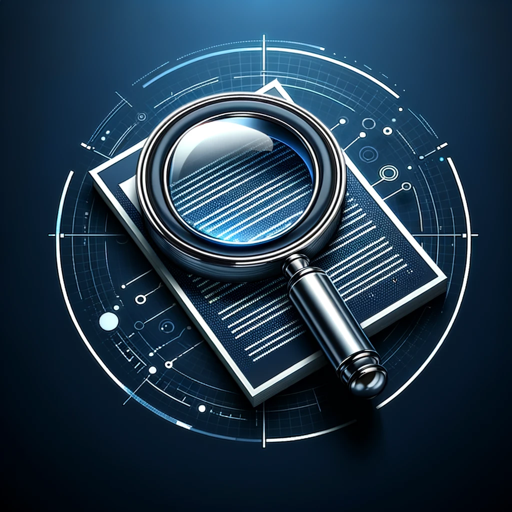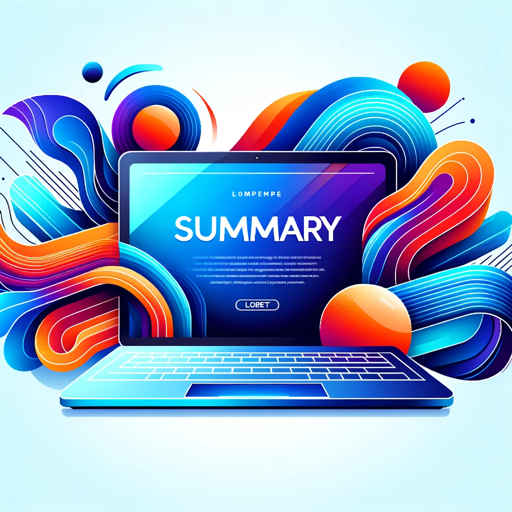Public Policy Evaluation-AI tool for policy evaluation
AI-powered policy evaluation tool
Rate Korean youth policy of employment with logic model.
Evaluate Japanese ISA policy with 5 factors.
Score USA social security policy.
Assess EU defense policy in 2022
Related Tools
Load More
政策研究 Policy Research
用于检索、整理和分析最新政策的综合工具 A comprehensive tool for searching, organizing, and analyzing the latest policies

Evidence-Based Practice
AI Assistant for Critical Appraisal of Scientific Articles
Personal agency evaluator
Fiverr Agency Evaluation Specialist

Policy Advisor
I assist public policy professionals with strategic policymaking for government

Political Analyst
Delve into the Intricacies of Politics: An Enlightening Journey Beyond Bias. Unbiased Expert Analysis & Dynamic Interactive Learning & Real-Time Updates & Accessible to All
政策解读专家
这是李继刚(即刻同名)创建的用于解读政策文件的 Bot。 模仿一位专门研究中国政策的学者,能对用户提供的新闻内容进行深入分析,并用通俗易懂的语言解释政府政策的深意。
20.0 / 5 (200 votes)
Introduction to Public Policy Evaluation
Public Policy Evaluation is a systematic process designed to assess the design, implementation, and outcomes of public policies. Its primary function is to determine the effectiveness, efficiency, equity, and sustainability of policies to provide insights for improvements or redesigns. This process involves collecting and analyzing data to measure the impact of policies on targeted problems, ensuring that public resources are utilized optimally. Evaluations often cover various aspects such as policy relevance, outcomes, impacts, and unintended consequences, helping policymakers, stakeholders, and the public understand the value of a given policy. For example, a government evaluating a new environmental policy aimed at reducing air pollution would collect data on air quality changes, assess the economic costs of implementing the policy, and analyze the distribution of benefits and burdens among different communities. This evaluation would help determine whether the policy is achieving its intended goals and at what cost, and provide recommendations for improving its effectiveness or addressing any unintended negative consequences.

Main Functions of Public Policy Evaluation
Assessing Policy Effectiveness
Example
Evaluating the success of a job training program by analyzing employment rates of participants before and after the program.
Scenario
A city government implements a job training program aimed at reducing unemployment among low-income residents. An evaluation is conducted to measure changes in employment rates, income levels, and job retention rates among participants. The findings help determine whether the program is achieving its intended outcomes and guide adjustments to enhance its impact.
Analyzing Policy Efficiency
Example
Evaluating the cost-effectiveness of a public transportation initiative by comparing the costs of implementation with the economic benefits gained from reduced traffic congestion.
Scenario
A metropolitan area introduces a new public bus service to reduce traffic congestion. Policy evaluators analyze the operational costs of the service, the reduction in travel times, and economic benefits such as increased productivity and lower vehicle emissions. The results provide insights into whether the transportation initiative offers good value for money or if resources could be better utilized elsewhere.
Ensuring Equity in Policy Outcomes
Example
Assessing whether a housing subsidy program equitably benefits low-income families across different racial and ethnic groups.
Scenario
A national housing subsidy program aims to provide affordable housing to low-income families. An equity-focused evaluation examines whether the program's benefits are distributed fairly among various demographic groups. This analysis helps identify disparities in access and outcomes, guiding adjustments to ensure that all eligible families benefit equally from the policy.
Ideal Users of Public Policy Evaluation Services
Government Agencies and Policymakers
These users include local, regional, and national government bodies responsible for designing and implementing public policies. They benefit from evaluation services to ensure policies are effective, cost-efficient, and equitable. Evaluations provide critical feedback that informs decision-making, budget allocations, and policy adjustments to better serve the public.
Non-Governmental Organizations (NGOs) and Advocacy Groups
NGOs and advocacy groups use policy evaluations to assess the impact of government policies on their target populations. They leverage this data to advocate for changes, support policy proposals, or highlight areas where current policies are failing. For example, an NGO focusing on education might use evaluation data to push for better funding for schools in underserved communities.
Academics and Researchers
Academics and researchers utilize public policy evaluation as a tool to study the effectiveness and impact of policies in their fields of expertise. They conduct in-depth evaluations that contribute to the broader body of knowledge on public policy and provide evidence-based recommendations that influence future policy design and implementation.

How to Use Public Policy Evaluation
1
Visit aichatonline.org for a free trial without login, also no need for ChatGPT Plus.
2
Identify the policy or program you wish to evaluate. Gather relevant data, reports, and metrics related to the policy.
3
Utilize the tool to input data, structure the evaluation using logic models, and assess different evaluation criteria such as effectiveness, efficiency, and sustainability.
4
Analyze the results provided by the tool, which will include Likert scale scores, detailed feedback on inputs, outcomes, and potential impacts of the policy.
5
Use the insights and evaluations to refine, recommend, or redesign policy measures, ensuring they meet objectives and serve the intended community effectively.
Try other advanced and practical GPTs
Biographical Question Generator
AI-powered tool for biodata questions.

Tradutor Qualquer Língua → Português de Portugal
AI-powered translation for European Portuguese.

C# Mentor
AI-Powered C# Programming Guide

Redator Halo
AI-Powered Content Creation Made Easy

Note Cards for Obsidian
AI-powered note cards for connected thinking

Lyric Composer
AI-powered lyrics for any genre

SOW Builder
AI-Powered Scopes for Creative Projects

Maple Coding Expert
AI-powered tool for Maple coding.

TLDR Article Summarizer
AI-powered summaries for quick insights

Don SQL
AI-Powered SQL Solutions

Tutor Me
AI-powered study assistant for students.

SN Community AI Helper
AI-Powered Assistance for ServiceNow

- Policy Analysis
- Resource Allocation
- Impact Assessment
- Program Evaluation
- Outcome Measurement
Public Policy Evaluation Q&A
What is Public Policy Evaluation?
Public Policy Evaluation is an AI-powered tool designed to assess the effectiveness, efficiency, equity, and sustainability of policies and programs. It helps users evaluate the inputs, outputs, and outcomes of policies, providing detailed insights to inform decision-making.
Who can benefit from using Public Policy Evaluation?
Policy makers, researchers, academic professionals, government agencies, and non-profit organizations can benefit from using this tool. It aids in thorough evaluations, supporting evidence-based policy development and refinement.
What are the key features of Public Policy Evaluation?
The tool offers a structured logic model for evaluation, Likert scale scoring for different criteria, detailed feedback on policy inputs and outcomes, and insights into long-term impacts. It’s designed for comprehensive and systematic policy analysis.
How does Public Policy Evaluation help in decision-making?
By providing a detailed evaluation of a policy's effectiveness, efficiency, equity, and sustainability, the tool helps decision-makers identify strengths and weaknesses, offering actionable insights for policy improvement or redesign.
Can Public Policy Evaluation be used for different types of policies?
Yes, the tool is versatile and can be used for evaluating a wide range of policies, including those related to education, healthcare, environmental protection, social welfare, and economic development.